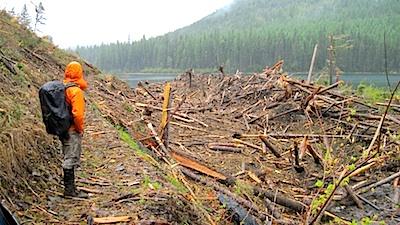
Damage to the Trout Lake Trail this past winter has Glacier officials suggesting hikers head to other trails/NPS
Though the calendar says mid-June, winter is returning to Glacier National Park in Montana, where the high country could get up to 2 feet of snow in the coming days, prompting park officials to warn visitors of challenging conditions.
"A weather system is predicted to impact the area beginning tonight through the next couple of days, including cooler temperatures and heavy precipitation. At this time, a winter storm warning has been issued in and around Glacier National Park for elevations above 6,500 feet with predictions of snow accumulations of one to two feet. The elevation at Logan Pass is 6,646 feet," park spokeswoman Denise Germann wrote in a release Monday. "Numerous trails in Glacier National Park are still snow-covered. Park staff report damage to trails and backcountry campsites due to snow slides and large amounts of avalanche debris."
Among the damage is the loss of the Ptarmigan Falls and Twin Falls bridges, which have been removed due to winter damage and hazardous conditions. Temporary bridges are not expected to be in place before July. The Iceberg Lake Trail is closed to stock use until permanent repairs to the Ptarmigan Falls B ridge are complete. Permanent repair work on both bridges is anticipated to begin this fall.
Extensive avalanche debris also has impacted the Trout Lake Trail. Hikers are not encouraged to use this trail; those that do should have route-finding skills to traverse the debris, the park warned.
Throughout Glacier's high country, trails "may traverse steep and sometimes icy snowfields, and hikers are strongly advised to have the appropriate equipment and skills to navigate such areas, or perhaps visit those areas once conditions improve," the park said.
Beneath the park's landscape, "frozen and damaged sewer and water lines caused some delays in seasonal opening activities for utilities park-wide. Rising Sun and the Swiftcurrent cabin areas experienced damaged water lines," wrote Ms. Germann. "The Apgar and Lake McDonald areas experienced issues with frozen sewer lines, and some broken water lines. The Cutbank, Many Glacier and Two Medicine campgrounds experienced delayed openings due to abundant snow accumulation and slow snow melt.
"A snow slide in the Alps area of the Going-to-the-Sun Road, about five miles west of Logan Pass, wiped out about 20-30 feet of rock wall along the road. Several new slide paths across the road have been encountered this spring, including the need for extensive snow and debris cleanup."
In spite of the problems, snow removal operations on the Going-to-the-Sun Road were contining with road crews working near the Big Drift and Lunch Creek areas east of Logan Pass, the spokeswoman noted.
"Above average snow accumulation and cool June temperatures have provided challenges for snow removal operations," she added. "The snow depth at the Big Drift is estimated to be about 80 feet, larger than recent years. Once the snow is removed, a thick layer of ice on the road is anticipated."
In addition to snow removal, "road crews are working to install more than 400 removable guard rails, sweep the road of rock debris, and clear snow from Logan Pass Visitor Center facilities including sidewalks and trails," wrote Ms. Germann. "Park road crew employees have begun working overtime in an effort to accomplish snow removal goals in a safe and timely manner, as well as other park employees assisting in the hand work to remove snow around facilities."
As of Monday, visitors were able to drive about 16 miles from the West Entrance to Avalanche on the west side of the park, and one mile from the St. Mary Entrance to the foot of St. Mary Lake on the east side. Whether there will be vehicle access to the Jackson Glacier Overlook area on the east side of the Going-to-the-Sun Road this coming weekend depends on the weather. There is no timetable for vehicle access to Logan Pass, and beyond Avalanche on the west side of park.
Hiker-biker access is currently available from Avalanche to the Loop on the west side, and from St. Mary to Rising Sun on the east side.



Comments
Excellent... hopefully that means less time for a significant fire season this year in that area.
Even as far south as Utah we have a winter storm warning for the mountains tonight. 6 to 10 inches of new snow expected above about 8000 feet.